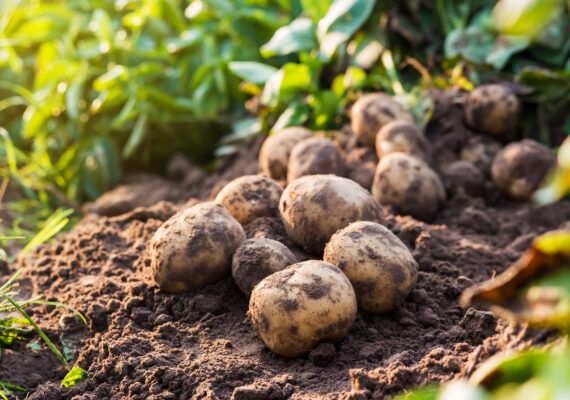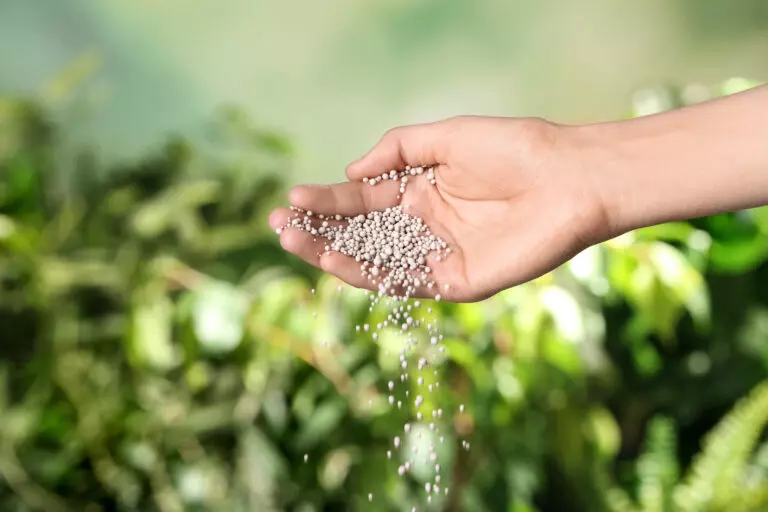
HOW TO PREPARE THE FIELD FOR PLANTING POTATOES?
The best results come from cultivating potatoes on flat terrain. The soil pH should range from 5.5 to 6.5. Early potato varieties require prolonged moisture retention in the substrate. The soil where the potatoes will be planted must be airy and properly loosened. It is best to perform shallow plowing and double harrowing the field already in autumn. In autumn, it is also beneficial to fertilize the field with manure and then plow it again. Before winter, the field can be enriched with phosphorus and potassium fertilizers, followed by plowing again – to a depth of 25 cm for lighter soils and 30 cm for heavier soils.
In spring, the area for potato cultivation should be harrowed again. If the soil is heavy, the field can also be plowed again. This is also a good time to apply nitrogen fertilizers, such as ammonium sulfate.
WHEN CAN POTATOES BE PLANTED?
The timing of planting potatoes in Poland depends on the region of the country. In Lower Silesia, they can be planted as early as mid-April, while in Suwałki – in the coldest region, potatoes are planted only in mid-May.
The timing of potato planting also depends on the type of soil. In light soils that heat up quickly, planting can be done sooner than in heavy soils that absorb water heavily.
Planting potatoes at the right time promotes abundant yields. If the tubers are planted too late, they will root poorly and will not be able to fully utilize the nutrients from the soil. Additionally, such vegetables will contain too much sugar, which is undesirable and contributes to a shorter storage time. If you want to grow early potatoes, you can start planting them between March and April when the temperature is 6 degrees Celsius. However, too deep planting of tubers may delay potato growth. They are usually planted in early April.
Even if our crop is affected by frost, there is no need to worry. Only the shoots will suffer, and potatoes have the ability to regenerate quickly and produce new shoots in their place. This allows plants to develop properly throughout the season. Potatoes can be planted until mid-May.
HOW SHOULD POTATOES BE PLANTED?
Prepared seed potatoes should be planted in the field when daytime temperatures no longer drop below 0 degrees Celsius. The critical temperature, which does not reduce crop yields, is considered to be 8 degrees above zero. Potatoes should be planted in rows spaced 60 to 65 cm apart. Plants in the row should be no closer than 20 cm and no further apart than 40 cm. Each potato should be covered with a 2 cm layer of soil.
Potatoes are best planted using a planter. Depending on the size of the seed potatoes, the planter can be set to row spacing: from 67.5 cm with a planting density of 30 cm, through a spacing of 75 cm and a planting density of 25-28 cm, up to a spacing of 90 cm with a planting density of 22 cm. In Poland, most farms are equipped with tractors that allow for row spacing of 67.5 cm. However, agriculture in Western Europe is moving towards increasing row spacing up to 75 cm. This improves the quality and yield of potatoes.
In the case of potatoes, it is also very important to weed the crop. Before the potatoes start to sprout, light harrowing can be done several times. Once the potatoes have emerged, hilling should be applied. It is also necessary to protect potatoes from pests such as potato beetles and potato diseases.
HOW TO FERTILIZE POTATOES?
These plants are best cultivated in soil in the second year after applying manure to the field. Potato cultivation will perform well on soils previously cultivated with wheat and rye. The optimal manure dose per 1 hectare is 25 tons.
Before planting potatoes, the field can be fertilized with mineral fertilizers, such as:
- ammonium nitrate at a rate of 250 kg per 1 hectare;
- triple superphosphate at a rate of 200 kg per 1 hectare;
- potassium salt at a rate of 200 kg per 1 hectare.
Fertilizer doses should be determined based on soil analysis results where the tubers are to be planted. It is important to avoid using excessive doses of nitrogen fertilizers for early potatoes. They can cause excessive growth of the aboveground part of the potato and delay tuber formation.

SHOULD THE SOIL BE LIMED BEFORE PLANTING POTATOES?
Liming, or soil fertilization, is a necessary procedure for potato fields as well. Potatoes grow well in acidic soils. They thrive best at a soil pH of 5.5 to 6.5. To achieve this pH, it is important to lime at the right time.
Potatoes react poorly to the fresh liming of cultivated fields. The lime dose should be selected based on current results from chemical analysis of soil samples. If the pH deviates significantly from the optimal level, lime should be applied in powdered form, such as Kujawit or Radkowit (for acidic soils with low magnesium content). When the pH is close to optimal, granulated lime should be used, such as Polcalc III Generation or SuperMag for soils with low magnesium content. Subsequent liming will not be effective for potatoes.
The field for potatoes can be limed using preparations such as:
- Polcalc III Generation;
- SuperMag, which is granulated magnesium lime.
Proper calcium and magnesium content, as well as the correct soil pH, promote abundant potato yields. Before performing any agricultural procedures, it is advisable to conduct soil analysis in a laboratory. Based on its results, appropriate fertilizer doses should be selected. If the soil in a particular area is deficient in nutrients, it is advisable to first lime soils deficient in magnesium and then perform appropriate mineral/organic fertilization, according to the results of soil sample analysis, which will show what deficiencies the soil has. This will allow for better absorption of mineral nutrients and healthy potato growth, as well as greater resistance to diseases. Liming activates and improves the uptake of elements by plants that are present in the soil in a difficult-to-absorb form. To lime magnesium-deficient soils, lime with magnesium should be used: SuperMag, Radkowit, Radkowit Premium.






